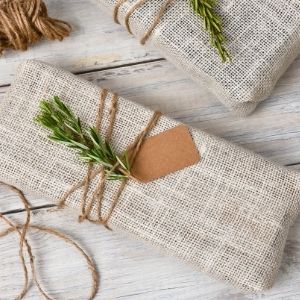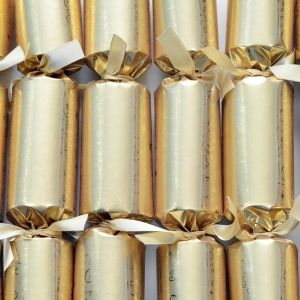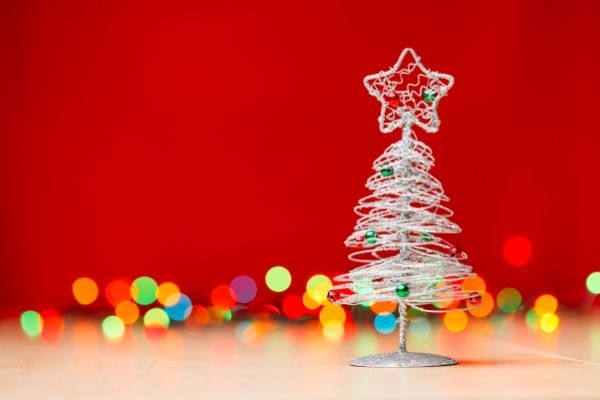Christmas is a wonderful time of year. It’s a time of celebrating and spending time with your loved ones. We all deserve an amazing Christmas this year, given the extraordinary events of 2020. Unfortunately, Christmas can also be a time of waste. The good news is that recycling at Christmas is easy. You can do many things to reduce your impact and still get a lot of joy out of the holidays.
Below are our tips and tricks for reducing your impact. It’s a good idea to start planning soon, though, ’cause it’s just around the corner.
1. Gift Buying
Giving gifts to people you care about is a fun tradition. Unfortunately, surveys have found about 61% of Americans get unwanted gifts over the holidays; that’s 154 million people. The numbers are similar in other countries too. The truth is many of us already have everything we need, and if we don’t, we generally go out and buy it. So when it comes to Christmas, the options can be limited.
Some families decide that it is no longer necessary to buy gifts or only buy them for children. This is a great step to take. However, if you can’t bring yourself to give up gifts or can’t talk your family around, here are some great options to reduce waste this Christmas.
- Give Kris Kringle or Secret Santa a go at home. This is where everyone selects a name from a hat and buys a gift for that one person rather than buying a gift for everyone. It means you can focus your efforts and your funds on one person, they get a better quality gift reducing the chance of them getting a gift they didn’t want.
- Why not ask your family what they really want or need. It might just save the item from being discarded after Christmas.
- Look for gifts that have a low or positive impact. Eco-Friendly gifts like metal straws or plastic-free alternatives can make great presents. A poll commissioned by ING in 2019 found about 25% of people would prefer an eco-friendly Christmas present.
- Look for recycled products. These are made from trash, so you are already one step ahead. You can check out many amazing recycled products here at Everyday Recycler.
- Browse our Recycled Brand Directory
- Check out our Recycled Store with our favorite products.
- Look through our Buy Recycled Guides
- Choose an experience for a gift. Maybe you could even share the experience with them and make a lasting memory.
- Choose to support a charity on behalf of your recipient.
- Make something out of materials that you already have.
Use your buying power for good, and check out our buy recycled guides.
- Buy Recycled: The Best Recycled Gifts For Women
- Buy Recycled: The Best Recycled Gifts For The Men in Your Life!
- Recycled Swimwear
- Recycled Backpacks
- Recycled Dog Products

2. Gift Wrapping
We all like shiny things, right! Did you know what makes gift wrapping, glitter, and tinsel shiny is actually a layer of plastic and metal? This attractive layering makes it pretty much impossible to recycle.
One of the best ways to reduce waste at Christmas is to swap these materials out for more eco-friendly choices. You can make a real difference just by making some small changes.
- If every American family wrapped just 3 of their presents in re-used materials, it would save enough paper to cover 45,000 football fields.
- In Australia, gift-givers use around 8,000 tonnes of Christmas wrapping paper every year.
- If every family reused decorative ribbon, a total of 38,000 miles of ribbon could be saved, that enough to tie a bow around the entire planet.
Here are our tips for gift wrapping.
- Re-use bits of wrapping paper you have lying around from last year. Why not make a patchwork masterpiece out of all the small unusable pieces of wrapping paper.
- Avoid shiny and metallic wrapping paper. As mentioned above, this type of wrapping paper is made from a plastic film and has to go to landfill.
- If you want to dress it up, use raffia, string, and paper bows. Traditional ribbons and bows are too hard to recycle and go to landfill.
- Buy recycled wrapping paper that can be recycled again.
- Have you tried fabric wrapping? It’s called furoshiki, it’s a lovely idea and can look beautiful. Just be careful not to buy new fabrics for this as textile waste is a bit of an issue. Maybe use some fabric you have around the house, or why not wrap your presents in a tea towel or something that can become part of the present.
- Use gift tags made from recycled paper and reuse them as much as you can.
- Why not go naked and forget the wrapping paper this year. You can have some fun with it, like hiding the gift in the house somewhere for them to find.
In summary, do your best to reuse what you have from last year, stick to paper, cardboard, and string or get inventive and use other materials around your home or garden. Buy recycled or better still go naked and don’t wrap the present at all.


3. Packaging
Recycling at Christmas includes many different types of materials. Whether it’s the product packaging or the delivery box the item arrived in, it’s important to recycle all of your packaging at Christmas.
You can reuse your delivery packaging. Fold it up, and keep it stored somewhere. This is especially useful if you plan to send presents to loved ones or sell things on eBay. Depending on whether your family read our tips above about gift-giving, you might have more to sell!
For the packaging that cannot be reused, here are our recycling tips. Don’t be shy about checking out our more detailed posts on the different materials to understand better what you can and cannot recycle.
- Cardboard can be recycled in your curbside recycling bin.
- Polystyrene packaging will need to be taken to a specialist recycler.
- Rigid molded plastic packaging can be recycled in your curbside recycling bin.
- Packing peanuts can be recycled at a few locations or may be biodegradable. The best option is to reuse them, then recycle them; otherwise, dispose of them. Check our article for more info.
- Plastic bags or other soft plastics like soft plastic packaging can be recycled at your local soft plastic drop off location. Check our article for links to find your nearest location.
4. Christmas Cards
I stopped using Christmas cards a few years ago. If I can repurpose last year’s Christmas cards, I’ll do that first. Otherwise, I pretty much write the person’s name on the wrapping or a small piece of card or paper.
It is nice to write a lovely message for your loved ones, so if you want to buy cards, look for cards made from recycled cardboard. Another idea is to send an electronic card; this is a nice way to send a message to more distant relatives and friends.
Most Christmas cards can be recycled as they are usually paper-based. Avoid recycling cards that have embellishments like glitter, ribbons, or foil. Also, keep an eye out for the ones that play music. My husband’s 95-year-old Grandad sends me one of these every year. It’s adorable. These cards have a battery in them, so make sure you remove it and recycle it at your nearest battery recycling point.
5. Christmas Trees
Did you know 7 million Christmas trees are sent to landfill every year in the UK? In the USA, about 17 million live trees are sold every year, and most of these also end up in landfill.
I was brought up with a fake Christmas tree myself. After I moved out of home, I couldn’t bring myself to buy a real tree, I was too worried about all the little creatures that might be living in it.
I also thought that having a fake one was better because I used the same tree over and over. I now know that may not have been the right decision. My fake tree is still in good condition, so I will keep using it for now. Using what you have is always the first piece of advice we give.
If you need a new tree or have been buying a real cut tree, there are a few new options these days. The best option that has popped up over the last few years is to rent your Christmas trees.
You can rent a real pine or fir trees in a pot, and then after Christmas, you return it to the company to be replanted. You can even purchase them after the holiday period and plant them in your garden—what a wonderful idea. Plus, imagine the extra cupboard space you will have when you don’t need to store the Christmas tree all year.
If you prefer a fake tree, then why not consider one that is made from recycled materials. This is a great option because it means you are using material that might otherwise end up in landfills.
Oncor Trees has been making Christmas trees since 1980. All their trees are made from recycled, non-toxic PVC plastic and have a 30-year life. Plus, they are part of 1% for the planet, which means they donate 1% of their profits to environmental organizations.
Another great option is to buy a second-hand Christmas tree. You can try your local second-hand store, Gumtree, Freecycle, or even eBay. I had a look myself, and there were quite a few on eBay that looked like they were in good condition. Not only does it reduce your impact, but it’s a great way to save money too.
Finally, one of my favorite options for an eco-friendly Christmas tree is to make your own. You can use all sorts of materials, depending on what you have. Let your imagination go wild and use anything around the house. There are some made with paper, old books, even pringle cans, or egg cartons. Here are some of our favorites.
Here are some options depending on where in the world you live.
USA
UK
- London Christmas tree rental
- Rental Claus
- Love a Christmas Tree
- Green Elf Trees – supporting out of work musicians and entertainers
Australia
In Australia, you can rent an artificial tree; however, I could not find a rental service for a live tree. Unfortunately, many rental companies are set up for businesses rather than homes. Hopefully, someone will see a business venture in this soon.
How to dispose of your Christmas tree
Check with your local authority when disposing of a real cut Christmas tree. You might be able to cut it up and put it in your general green waste bin, or your local authority may have a special pick-up after the holiday period. Many recycling centers will accept trees at no extra charge. Sometimes the companies that deliver cut trees will also offer a service to pick it up later. There are even tree recycling/mulching programs popping up in many communities.
If you have a fake tree, make sure it is really at the end of its life. If it is still in reasonable condition, then consider keeping it. You can spruce it up with some new eco-friendly decorations. Or perhaps donate your tree to a local charity or try Freecycle or gumtree. Otherwise, unfortunately, your fake tree will need to go into the general waste for landfill. Most fake trees are made from PVC, plastic number 3, which is very difficult to recycle.
6. Christmas Decorations
Christmas decorations can be made from many different materials like glass, plastic, wood, or metals. Unfortunately, the majority of decorations cannot be recycled. They are often made from a mix of different materials or simply made from materials that cannot be recycled. Here are the most popular and some possible swaps you can make.




- Tinsel
- Made from – shiny plastic sheets, tinsel cannot be recycled.
- Disposal – must be thrown into your general trash can.
- Alternatives – Make your own bunting out of old fabric pieces or last year’s Christmas cards.
- Glass Baubles
- Made from – Unfortunately, glass baubles cannot be recycled. It’s hard to know what type of glass is used, so it’s most likely it will create contamination.
- Disposal – Put them in your general trash can.
- Alternatives – Try buying recycled glass baubles. Buy good quality and look after the ones you have.
- Plastic baubles
- Made from – Often made from types of plastics that are not collected in curbside recycling like plastic number 7
- Disposal – Put them in your general trash can.
- Alternatives – Old baubles, whether they are glass or plastic, can be repainted or decorated with other objects. They can also be used to create mosaics or make a bauble wreath.
- Wreaths
- Made from – Natural materials or fake plastic similar to a Christmas tree. They may also be made from many other materials.
- Disposal – If your wreath is made from natural materials, then it can be disposed of in your garden waste as long as there is no glitter or other objects glued to it. Any other natural material like fir cones, holly, or mistletoe can also go into your compost or green waste bin. Artificial wreaths cannot be recycled and will need to be disposed of in your general trash can.
- Alternatives – Be sure to pull apart wreaths and reuse the different pieces for other decorations or a new wreath. You can make a new wreath out of many different objects around the house. Get creative and see what waste materials you can use.
- Christmas Crackers
- Made from – they seem harmless, but Christmas crackers to me represent the real throw-away society that we have become. On the outside, they are harmless, made from paper and cardboard, and colorfully decorated. And who doesn’t love the loud bang you get when you crack them. However, on the inside, they are much more sinister. Haha, maybe not sinister but certainly very wasteful. They contain some small pieces of plastic that you do not need, and that cannot be recycled.
- Disposal – The paper and cardboard can be recycled as long as it is not covered in glitter or shiny paper. The jokes are a bit too small to recycle. (possibly they are already recycled, haha). The plastic toy will definitely not be recyclable and must be thrown in the general waste.
- Alternatives – Maybe you could make your own and put something like chocolate in them or even put a donation card to ocean pollution and put the non-profit’s name in each.
It is a good idea to keep these to a minimum and look for Christmas decorations made to last or made from eco-friendly materials like timber or metal.
When buying Christmas decorations, look for good quality that will last a long time or, better still, make your own. Here are some ideas to give your old decorations new life.
7. Christmas lights
Christmas lights are made from plastic, metal, and glass and will take hundreds of years to break down. The lights used in many are compact fluorescent lightbulbs (CFLs). CFLs contain mercury, which can leach into the environment if they are disposed of in landfills. They don’t go into your general waste bin or your curbside recycling bin.
Christmas lights can be recycled at specialist locations. Check with your local authority to find your nearest drop-off point or try your local recycling center.

It’s really important to think about how much energy and materials have gone into making your Christmas lights. If they still work, keep using them and ask yourself do you really need a new set. It’s also very important to take care of the lights you have. There are lots of things you can do to take care of them.
- First, buy good quality lights that will last longer.
- Take your lights down as soon as the holiday festivities are over. Weather and the elements take their toll on the plastic and other materials.
- Store lights in a good watertight container, especially if you keep them in the garage.
- Check for missing or broken light globes before you put them away. Believe me, you will appreciate it in a year when you can pull them out of storage and put them straight up.
- Make a light stand out of some timber or a piece of cardboard that you can wrap the lights around to store them carefully.
Here are a few links for recycling old Christmas or fairy lights, depending on your location.
USA
If your Christmas lights are still working, try Goodwill and other charities. If they are at the end of their life, contact your local authority or recycling center to see if they accept them. Otherwise, here are some other options.
- Many e-recycling services will accept Christmas tree lights as part of their small electrical collections.
- MOM’s organic market does an annual recycling drive for your holiday lights. You can check their locations here. https://momsorganicmarket.com/recycle-center/#. Note they also recycle batteries, corks, cell phones, shoes, compost, and oyster shells.
Another option is to find a company recycling service. Some companies will take your old broken lights and give you a discount on new ones in their store. Here are a couple of examples.
- Christmas Light Source
- Holiday LEDs
- Green Citizen also has a mail-in service
- Environmental LED
UK
In the UK, Christmas lights or fairy lights are classed as Waste of electrical and electronic equipment (WEEE), which is equivalent to e-waste. Local authorities will usually accept Christmas tree lights as part of their small electrical collections.
Australia
In Australia, you can recycle old and broken Christmas lights in lighting recycling or e-waste recycling programs. Many local authorities have programs, or your local transfer station may accept them. Check the planet ark website to find your nearest drop-off point.
8. Food waste
Food waste is a big problem in the western world, and Christmas is a big part of the problem. We almost always over cater for Christmas day. We eat too much, but sometimes we cannot keep up with the leftovers and their expiry dates. I have been trying to get my family to reduce the amount of food we prepare, and we have had a little success, but we still struggle. Everyone wants to make their favorite recipe, and there are so many foods that have such a great Christmas feel to them.

It is an excellent idea to try and avoid food waste as much as possible. The added benefit is you might find less on your hips too. Not to mention you might save some money too. Here are some tips to help you:
- Plan your meal carefully. Use online tools to help you calculate the amount of food you need for the number of people you will have. Here is some great information from Good Housekeeping on how to calculate the size of your turkey or roast for Christmas.
- Make clear plans with your family or friends rather than just asking them to bring a plate.
- Don’t make extra just in case.
- Cover food and refrigerate leftovers as soon as you can.
9. Paper Plates and Plastic Cutlery
If you can avoid using single-use plastics like plates and cutlery, that is the best option. If you cannot avoid it, then try to find alternatives like biodegradable or plant-based plates. Maybe if you have a big crowd coming, you can get everyone to bring their own knife, fork, and plate. Just make sure they remember to take them home with them.
Disposable plates and cutlery go in the general waste bin, they cannot be recycled. Maybe this is a good time to put the call out and let everyone knows that you need more crockery or cutler and that it would be an excellent present for next year’s Christmas!
Other everyday disposable items used at Christmas are paper towels and serviettes. Once used, these must be placed in the trash bin. Paper towels and serviettes cannot be recycled. These items have generally already been recycled at least once, so the paper fibers are no longer useful. Plus, they are generally contaminated with loads of food and other material.
All that food at Christmas is surely going to come in a lot of plastic packaging. Are you familiar with the term soft plastics? If you are not, then Christmas is a perfect time to learn about it.
Soft plastics are soft scrunchable plastic like a plastic bag, a pasta packet, lolly wrappers, biscuit packets, chocolate packets, cereal box liners, to name a few. Although these soft types of plastic cannot go in your curbside recycling bin, they can be recycled at a specialist recycler. You can check out more in our soft plastics article and even find drop-off locations near you.
Finally, don’t forget to recycle all that aluminum foil and the aluminum trays you use this year. Make sure it is clean and then roll it all together and throw it in your curbside recycling bin.
Recycling at Christmas is important so make sure you recycle right and have a great Christmas.
Sources
- Nicole Cruz, 2019, Shocking Holiday Waste Statistics That Will Make You Feel Guilty This Christmas
- Stanford PSSI/Stanford RecyclingLand, Buildings & Real Estate, Frequently Asked Questions: Holiday Waste Prevention
- John Collett, 2019, Christmas waste revealed in $400m of ‘unwanted’ gifts














